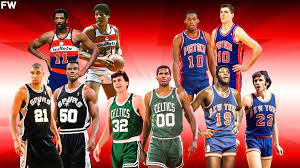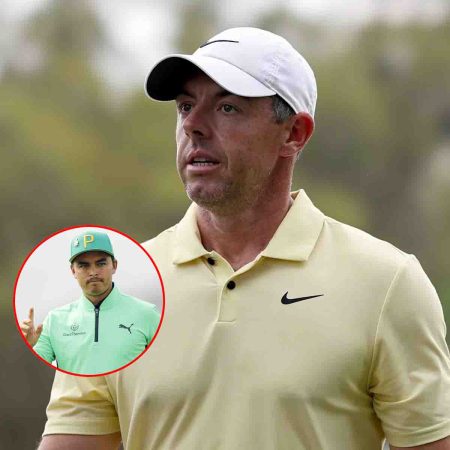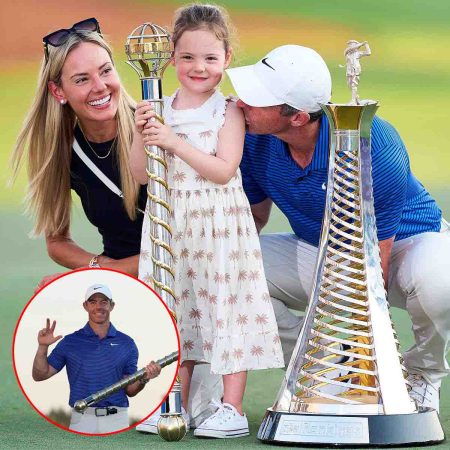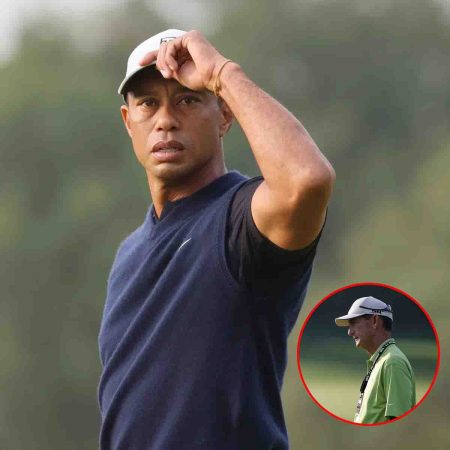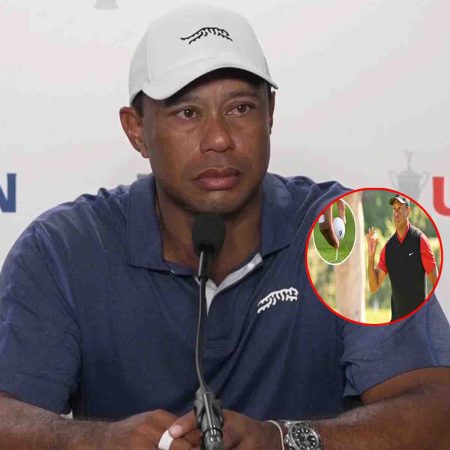Having an elite NBA frontcourt has been the catalyst for many successful teams throughout NBA history. For most, the frontcourt consists of the power forward and center positions, often the biggest and the strongest members of any lineup. When we take a look at the greatest NBA players in history, more than half were prominent members of an elite NBA frontcourt that consisted of MVPs and NBA champions.
Just as we did earlier this month with the greatest NBA backcourts, today we will take a look at the greatest NBA frontcourts ever. It is understood that many may believe small forwards should count toward the frontcourt, but we will focus solely on power forwards and center duos. You will recognize these duos for what they did individually and for what they accomplished together on the court, which made for some of the greatest moments in NBA history.
These are the 10 greatest frontcourts in NBA history.
10. Karl Malone And Mark Eaton
Credit: Fadeaway World
Years Together: 8 (1986-1993)
NBA Finals: 0
NBA Championships: 0
Karl Malone’s Stats: 26.1 PPG, 10.9 RPG, 2.8 APG, 1.4 SPG, 0.8 BPG
Mark Eaton’s Stats: 5.7 PPG, 7.9 RPG, 0.8 APG, 0.4 SPG, 3.1 BPG
Back in the 1980s and 1990s, the name of the game was to protect the paint and rim at all costs. That is exactly the job that Mark Eaton was brought in to do in his career with the Utah Jazz, and he did it extremely well. Eaton was with Utah for three seasons before the Jazz acquired some offense in their frontcourt and drafted Karl Malone in 1985. With Malone scoring at will and rebounding the ball extremely well, Eaton thrived as a rim protector and rebounder as well.
Although this frontcourt struggled to get past a certain point in the playoffs, it is hard to argue with the player who scored the third most points in NBA history and the player who recorded the fifth most blocks in NBA history. You could argue that Eaton’s offensive shortcomings hindered Utah’s success, but his defense was crucial to their success as well. Malone, meanwhile, turned into a perennial All-Star and one of the best power forwards of all time. He averaged 25.0 PPG or better in six of the eight seasons he spent with Eaton as well as 10.0 to 11.0 RPG consistently.
9. Bob Pettit And Ed Macauley
Credit: Fadeaway World
Years Together: 3 (1957-1959)
NBA Finals: 2
NBA Championships: 1
Bob Pettit’s Stats: 26.2 PPG, 16.1 RPG, 2.4 APG
Ed Macauley’s Stats: 14.4 PPG, 6.1 RPG, 2.3 APG
The time that Bob Pettit and Ed Macauley spent together in the late 50s with the St. Louis Hawks was short-lived but fruitful. Macaulay had been a six-time All-Star with the Boston Celtics before joining the Hawks in 1957, while Pettit was headed into his third season, coming off an MVP campaign in 1956. The two would lead the Hawks to a 34-38 record as All-Stars in their first season together, as well as an appearance in the 1957 NBA Finals which they lost to the Celtics in seven games.
The following season would be redemption for the duo as Pettit would average 24.6 PPG, and Macauley added 14.2 PPG along with 5.1 RPG. The pair would lead the Hawks back to the NBA Finals, where they would meet the Celtics once again. Macaulay would come off the bench for the series but appear in all six games and averaged 5.8 PPG and 6.3 RPG. Pettit would help the Hawks become the only team to defeat Bill Russell in the NBA Finals behind 29.3 PPG and 17.0 RPG. Macaulay and Pettit would spend one more season together in which Pettit was named MVP while Macauley retired after the season concluded.
8. Maurice Lucas And Bill Walton
Credit: Fadeaway World
Years Together: 2 (1977-1978)
NBA Finals: 1
NBA Championships: 1
Maurice Lucas’ Stats: 18.4 PPG, 10.3 RPG, 2.7 APG, 1.0 SPG, 0.8 BPG
Bill Walton’s Stats: 18.8 PPG, 13.8 RPG, 4.4 APG, 1.0 SPG, 2.9 BPG
Maurice Lucas and Bill Walton were another frontcourt duo that didn’t spend a ton of time together, but they sure made it worth it. Lucas played in the ABA up until the merger at the end of the 1976 season when he joined the Trail Blazers for 1976-77. Walton was heading into his third season with Portland and becoming one of the better two-way interior presences in the entire NBA. Their first season together was magic as they each earned All-Star selections while Walton led the NBA in rebounds and blocks with 14.4 RPG and 3.2 BPG. The team won 49 games, and the duo led Portland all the way to the NBA Finals.
In the NBA Finals, it would be Lucas and Walton leading them to victory in six games. Lucas led the team in scoring with 19.7 PPG, 10.7 RPG, and 1.8 SPG. Walton added 18.5 PPG, 19.0 RPG, 5.2 APG, 1.0 SPG, and 3.7 BPG to take home Finals MVP honors. In their second year together in 1978, Walton was awarded the MVP award as both he and Lucas earned All-Star selections once again. In the playoffs, Walton suffered an injury that would change the course of his career forever, and Lucas was unable to carry the load himself. Walton was out for a full season, then returned with the Clippers in 1979, while Lucas remained with Portland through the midway point of 1980.
7. Rasheed Wallace And Ben Wallace
Credit: Fadeaway World
Years Together: 3 (2004 thru 2006)
NBA Finals: 2
NBA Championships: 1
Rasheed Wallace’s Stats: 15.2 PPG, 7.3 RPG, 2.1 APG, 0.9 SPG, 1.6 BPG
Ben Wallace’s Stats: 8.8 PPG, 11.9 RPG, 1.8 APG, 1.7 SPG, 2.5 BPG
The duo of Rasheed Wallace and Ben Wallace didn’t come together until they were both into the meat of their careers. Rasheed had already been an All-Star in Portland, and Ben was already a two-time Defensive Player of the Year in Detroit. After the 2003 season and partially through 2004, Detroit realized if they wanted to get to the next level as a team, they needed one more piece to put them over the top. The deal for Rasheed Wallace in 2004 was the piece they needed.
The duo of unrelated Wallaces made for one of the most intimidating defensive forces in the NBA, and they rode that wave all the way to the NBA Finals after just 22 regular season games together. The two anchored the Pistons against the favorite Los Angeles Lakers as they went on to win the NBA Finals in five games. The pair would do the same for Detroit in 2005 as they advanced to the NBA Finals once again with stellar seasons from both Rasheed and Ben. This time, they would fall to the San Antonio Spurs in seven games. By the end of 2006, Detroit had decided to move on from Ben, and Rasheed remained with the Pistons until 2009.
6. Hakeem Olajuwon And Ralph Sampson
Credit: Fadeaway World
Years Together: 4 (1985-1988)
NBA Finals: 1
NBA Championships: 0
Ralph Sampson’s Stats: 18.7 PPG, 10.2 RPG, 3.0 APG, 1.0 SPG, 1.8 BPG
Hakeem Olajuwon’s Stats: 22.5 PPG, 11.8 RPG, 2.1 APG, 1.8 SPG, 3.0 BPG
This next NBA duo is one of the biggest what-ifs in NBA history. The frontcourt duo known as the Twin Towers made up of Ralph Sampson and Hakeem Olajuwon, was every team’s nightmare during the 1980s. This ranking may seem a little high, but these two giants were on their way to sustained success during their era had it not been for Sampson’s foot injury that changed everything. Sampson was in just his second season when the Rockets decided to pair him with Olajuwon through the draft, and by their second season together were already championship contenders.
Both men were All-Stars in each of their first two years together and, in 1986, led the team to 51 wins and a trip to the NBA Finals. In the series against the Celtics, both Olajuwon and Sampson were great, but the experience of the Celtics shined through for their third championship of the decade. Sampson would earn another All-Star selection but suffered an injury 43 games in that would end his reign as one of the top big men in the game. It would take some time for Houston to recover from losing Sampson, but eventually, Olajuwon led them to two championships in 1993 and 1994.
5. Dennis Rodman And Bill Laimbeer
Credit: Fadeaway World
Years Together: 7 (1987-1993)
NBA Finals: 3
NBA Championships: 2
Dennis Rodman’s Stats: 8.8 PPG, 11.5 RPG, 1.3 APG, 0.7 SPG, 0.7 BPG
Bill Laimbeer’s Stats: 12.0 PPG, 8.7 RPG, 2.0 APG, 0.7 SPG, 0.8 BPG
The next duo on here can definitely be classified as the meanest and most hated of the entire group. Bill Laimbeer and Dennis Rodman were at the heart of the Pistons’ Bad Boy era that saw them advance to three NBA Finals and win two NBA championships. Laimbeer was already on the back end of his prime when Rodman was selected in the 1986 NBA Draft by Detroit. Rodman initially came off the bench until the 1990 and 1991 seasons, but it was undoubtedly he and Laimbeer that made the most defensive impact on the floor.
Laimbeer was a true enforcer and the anchor of three straight Finals appearances from 1988 thru 1990. In 1988, the Pistons fell to the Lakers in the NBA Finals. They would have their revenge the following season in the Finals once again as they swept the Lakers in four games to capture their first championship. Rodman led the team in rebounding with 10.0 RPG, while Laimbeer did a bit of everything to contribute to the win. In 1990, it would be Laimbeer to lead the duo with over 13.0 PPG and 13.0 RPG to help aid in their second straight NBA championship.
4. Elvin Hayes And Wes Unseld
Credit: Fadeaway World
Years Together: 9 (1973-1981)
NBA Finals: 3
NBA Championships: 1
Elvin Hayes’ Stats: 21.3 PPG, 12.7 RPG, 1.8 APG, 1.1 SPG, 2.4 BPG
Wes Unseld’s Stats: 9.2 PPG, 12.4 RPG, 4.1 APG, 1.1 SPG, 0.6 BPG
Elvin Hayes and Wes Unseld were completely opposite off the court from all accounts but played in perfect sync on it. The nine years this duo spent together resulted in three appearances in the NBA Finals and one NBA championship in 1978. The two were a perfect complement of one another, with Unseld being a force on the defensive end and rebounds while Hayes was a scorer and defender of the highest caliber as well.
Hayes came over to the Baltimore Bullets in 1973, and both he and Hayes would have All-Star seasons. Two years later, they made their first Finals appearance but fell to the Golden State Warriors. In 1978, Hayes and Unseld led the Bullets to an NBA championship in seven games over the SuperSonics. Unseld would grab Finals MVP honors for his defensive performance, while Hayes averaged 20.7 PPG and 11.9 RPG. The duo would make another Finals appearance in 1979 against Seattle. This time, they fell in five games. Any duo that makes three Finals appearances and wins at least one will be recognized as one of the best frontcourts ever.
3. Dave DeBusschere And Willis Reed
Credit: Fadeaway World
Years Together: 6 (1969-1974)
NBA Finals: 3
NBA Championships: 2
Dave DeBusschere’s Stats: 16.0 PPG, 10.7 RPG, 3.1 APG, 0.9 SPG, 0.5 BPG
Willis Reed’s Stats: 18.3 PPG, 12.4 RPG, 2.0 APG, 0.6 SPG, 1.1 BPG
The frontcourt of Dave DeBusschere and Willis Reed during the early 1970s was hands down the best in basketball. This duo didn’t get together until partway through the 1969 season, but it couldn’t have come at a better time. DeBusschere became a double-double player with over 16.0 PPG and 10.0 RPG in his Knicks career, while Reed was playing at an MVP level just as he always did. In their first season as teammates, Reed won the MVP award while DeBusschere earned All-Star honors, but they were not done yet.
The next four seasons would be all about the New York Knicks. To cap off 1970, Reed led the Knicks to victory over the Lakers in seven games for their first NBA championship. DeBusschere was second behind Reed in points and rebounds as the duo became NBA champions in less than two full seasons together. The Lakers got their retribution in 1972 in a dominant five-game series win over the Knicks and their star cast. In 1973, Reed and DeBusschere led the Knicks back to the NBA Finals and handed the Lakers a beatdown of their own. Reed earned Finals MVP honors, while DeBusschere averaged over 15.0 PPG and 11.0 RPG.
2. Tim Duncan And David Robinson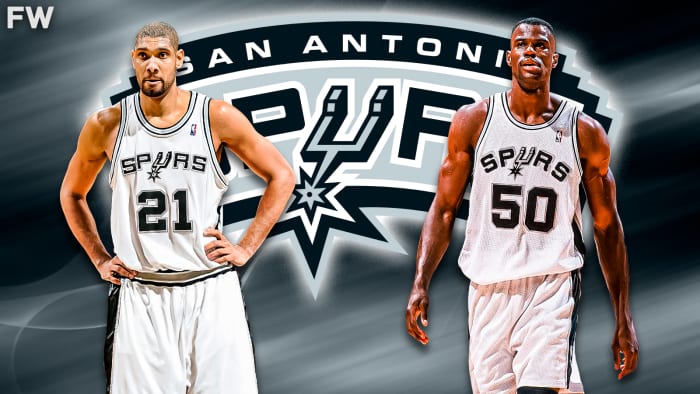
Credit: Fadeaway World
Years Together: 6 (1998-2003)
NBA Finals: 2
NBA Championships: 2
Tim Duncan’s Stats: 22.9 PPG, 12.3 RPG, 3.2 APG, 0.8 SPG, 2.5 BPG
David Robinson’s Stats: 15.2 PPG, 9.2 RPG, 1.7 APG, 1.1 SPG, 2.2 BPG
For years during the 1990s, David Robinson could only get the Spurs so far on their quest for optimum success in the NBA. The former MVP and Defensive Player of the Year was among the top centers in the game at the time, but the Spurs always seemed to fall just shy of a championship or even a shot at one. Then, along came Tim Duncan in 1998, and alamo immediately changed everything. Robinson and Duncan became the best all-around frontcourt in the NBA and an especially difficult defensive tandem.
The Spurs won 37 games in a lockout-shortened season in 1999 and were among the best teams in basketball through 50 games. Duncan and Robinson led the team in points, rebounds, and blocks as the Spurs ran through the Knicks in five games. Duncan was named Finals MVP, and Robinson had his first NBA title. Robinson would have two more All-Star seasons despite being at the end of his career, and Duncan became one of the game’s biggest stars. In 2003, Duncan and Robinson would have the perfect sendoff as Robinson was set to retire. The duo delivered another championship, with Duncan securing Finals MVP honors again. Robinson was limited but effective, with 10.8 PPG, 7.3 RPG, and 1.8 BPG.
1. Kevin McHale And Robert Parish
Credit: Fadeaway World
Years Together: 13 (1981-1993)
NBA Finals: 5
NBA Championships: 3
Kevin McHale’s Stats: 17.9 PPG, 7.3 RPG, 1.7 APG, 0.4 SPG, 1.7 BPG
Robert Parish’s Stats: 16.8 PPG, 10.2 RPG, 1.5 APG, 0.8 SPG, 1.6 BPG
For argument’s sake, Larry Bird can be included in this frontcourt, considering he played the power forward position on the court as well. The trio was a well-oiled machine with Bird and Parish as solidified starters and McHale earning his way as one of the best bench players in basketball and eventually starters. The trio would make a total of five NBA Finals together, winning three NBA championships during the 1980s. McHale and Parish were brought to the Celtics in one of the most lopsided deals in NBA history after Parish spent some time with the Warriors.
In 1981, their first full season together, the Celtics won an NBA championship. Parish and Bird were stars, but McHale had yet to break the rotation in a significant way. That would not be the case on their next championship run in 1984. In a seven-game series win, Bird was named Finals MVP as Parish averaged a double-double and McHale averaged over 13.0 PPG off the bench. This legendary Boston frontcourt would add one more championship in 1986. This time, McHale led the team in scoring with over 25.5 PPG, Bird nearly averaged a triple-double, and Parish went for over 12.5 PPG and 6.0 RPG. With three NBA championships in a six-year span, and all of them contributing in major ways, they have to be considered the greatest frontcourt in NBA history.



